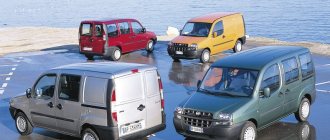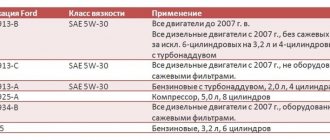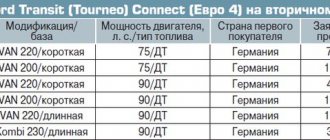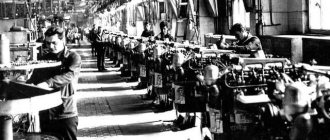Historical reference
The first generation rolled off the assembly line in 1950, at that time the model's load capacity was 860 kg, which was a lot. The model's windshield was divided into 2 parts, and in the front of the car there was a large Volkswagen badge.
The second generation became significant for the entire model. A new version of the Volkswagen Transporter appeared in 1967, the designers retained the main features of the chassis and design. The popularity of the 2nd generation was enormous, approximately 70% of the cars were exported. The main differences are a modified engine line, larger dimensions, and a modified suspension. Production of the model was stopped in 1979, but in some countries, namely Mexico and Brazil, they began producing this modification in 1997, and stopped production in 2013.
With the onset of the 80s, the 3rd generation of the Volkswagen Transporter came out, which contained a lot of new things.
:
- Extended wheelbase.
- Increased dimensions and load capacity.
- The engine remained at the rear of the car, as in the second generation.
- A lot of additional equipment appeared, including electric mirrors and power windows.
Later there was a restyling, so the car survived the introduction of all-wheel drive and air conditioning. The main disadvantage of the Volkswagen Transporter is the poor quality of the metal; some parts quickly became rusty. By the 90s, the version became unpopular, so manufacturers had to create a new generation.
The 4th generation Volkswagen transporter caused a sensation among many fans of the brand and model
:
- The appearance and design have completely changed.
- All models were front-wheel drive.
- You could buy all-wheel drive.
- Several types of body, for freight transport and for transporting people.
At the end of 1990, minor changes took place, and the Volkswagen Transporter was slightly modified.
The 4th generation was replaced by the Volkswagen Transporter T5, which debuted in 2003. Technical updates have been added, the engines are equipped with new injection, supercharger and much more. More expensive modifications had an automatic transmission.
The latest generation T6 has not received many major changes in comparison with the Volkswagen Transporter T5. The technical components have remained almost unchanged; the body and decorative elements have changed somewhat.
Model history
The first minibus was produced by Volkswagen in 1950. Dutchman Ben Pon created the Volkswagen T1 and laid the foundation for the Transporter model range. The car was produced in the city of Wolfsburg. It was a rear-wheel drive minibus that could carry up to 850 kg of payload. Eight people could ride in the car with the driver. The T1 was produced from 1950 to 1966.
The body dimensions were 4.5 x 1.7 x 2 m, and the wheelbase length was 2.4 m.
It was equipped with a manual transmission and was equipped with one of three engines, which were located at the rear:
- 1,1;
- 1,2;
- 1.5 l.
The second modification, VT2, rolled off the assembly line in Hannover in 1967. It was an improved version of T1. The cabin became more comfortable, and the front glass was made from a single piece. The design of the rear suspension has been redesigned, making it more reliable. The engine cooling also remained air-cooled, but the volume increased slightly. VT2 was equipped with four types of power units:
- 1,6;
- 1,7;
- 1,8;
- 2 l.
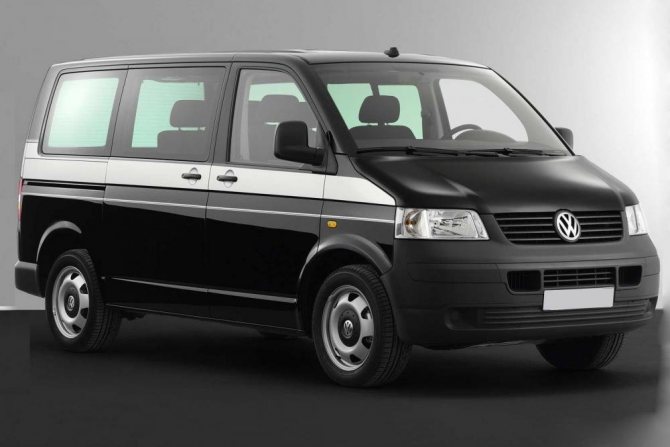
The buyer could choose a manual or automatic transmission. The body dimensions and wheelbase length did not change.
Further development of the Transporter was as follows:
- The T3 is the latest model with a rear engine. ICEs were installed in both gasoline and diesel engines. Completed with manual and automatic transmission;
- T4 - began production in 1990. The car became the most popular of all Transporters and was produced until 2003. The internal combustion engine was moved forward, the car became front-wheel drive. The suspension has also been improved;
- T5 - began to be produced in 2003. They were produced with front-wheel drive and all-wheel drive. They are still in production, and the car has become very popular in the EU and CIS.
Read also Review of Volkswagen Amarok 2020
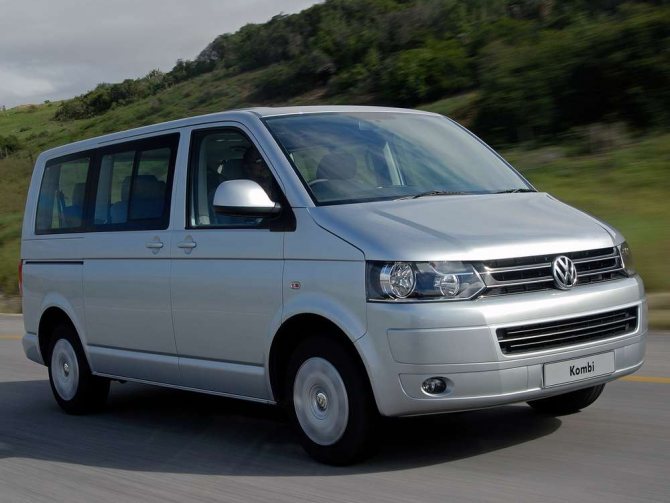
The latest modification of the Volkswagen Transporter is the T6 2017.
Engines
Minivans of almost any generation are distinguished by a large selection of engines that have good potential and low fuel consumption. Gasoline models are considered less reliable than diesel ones. Although there are many disputes with diesel engines, some note that they are not the most successful, while other experts claim that the engines are ideal.
It is the Volkswagen Transporter with diesel fuel that remains the most popular in the secondary market. They are not whimsical, have low fuel consumption, are designed simply, due to which they rarely fail. In addition, they are repairable.
Pros and cons of the T5 version
The Volkswagen Caravel T5 has its advantages and disadvantages.

What are the advantages of the model?
- ease of control;
- economical fuel consumption;
- good acceleration;
- the presence of a high landing;
- high-quality power units;
- reliable security systems;
- two-zone climate control;
- cabin capacity.
Owners also note some typical shortcomings of the model. These include:
- insufficiently reliable gearbox;
- poor cylinder head fastening;
- body susceptibility to corrosion;
- rigid suspension.
Read also Review of the stylish subcompact Volkswagen Polo 2018
If there are these disadvantages, the model is in demand among Russian car enthusiasts. The presence of certain weaknesses in the Caravel is more than compensated for by its functionality, engine variations and affordable price.
Fuel consumption
Since the 4th generation Volkswagen Transporter is the most popular, many people drive them today, the fuel consumption will be indicated for this model. Like other Volkswagen Transporter T4 cars, they were equipped with different types of engines, there were diesel as well as gasoline units:
- The first models were produced with 2-liter gasoline engines with a power of 85 hp, with a manual transmission. Gasoline consumption is 11.1 l/100 km in the urban cycle, and on the highway at 90 km/h it is about 8 l.
- The following models were 2.5-liter, more powerful - 115 hp. These versions were equipped with a 4-speed automatic transmission and all-wheel drive. Fuel consumption of this model in the city is 12.5 liters, while on the highway it is 7.8 liters.
- The 2.8 liter engines have become stronger, their peak power is 140 hp if MPKK is used and 204 hp. when using an automatic transmission. Fuel consumption standards for the Volkswagen T4 are 13.2 liters in city mode or 8.5-9 liters on the highway.
As for diesel cars, they are considered more reliable and economical, of course, with less power
:
- The first models were produced with the famous 1.9-liter engines. Such cars were rated at 60 and 68 hp. The average fuel consumption of the Volkswagen Transporter T4 diesel is 9.1 liters in the urban cycle, and on the highway the figures can be reduced to 7 liters.
- After some time, they began making 2-liter engines with an output of 84 hp, while consumption increased to 9.3 l/100 km in the city. On the highway, consumption dropped to 6.7 liters.
- The most powerful were 2.5 liter engines with 102 hp. Such models were sold not only in front-wheel drive, there were all-wheel drive versions. This unit turned out to be more economical than weaker models and in the city the consumption is 7.6 liters, while on the highway it is about 6.5 liters.
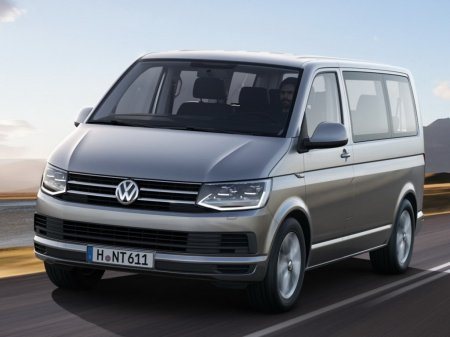
Any Volkswagen Transporter T4 running on diesel fuel was equipped with a manual gearbox.
The 5th generation Volkswagen Transporter went on sale in 2003. Diesel fuel vehicles are available in several variants
:
- 1.9-liter unit with 102 hp. with a turbine. Only a manual transmission was equipped. The fuel consumption of the Volkswagen T5 on the highway is 5.9-6.4 liters, and in urban conditions 7.6-7.7 liters.
- 2.5-liter engines of different power 131 and 174 hp. with turbines. They were equipped with automatic and manual transmissions, and there were versions with all-wheel drive. The real fuel consumption of the Volkswagen Transporter (diesel) in the city is 9.4 liters, on the highway - 8 liters.
In addition to diesel fuel, there were 2 versions with gasoline units, with different gearboxes and drives
:
- Engine with a volume of 2 liters and a power of 115 hp. Fuel consumption is about 11 liters in the city, up to 8 liters on the highway.
- Engines are 3.2 liters with a power of 235 hp. Since the car is more powerful, fuel consumption during city driving is 12.4-12.9 liters, and outside the city – up to 9 l/100 km.
After 2009, when the Transporter was restyled, only one 2-liter engine remained in production. If it runs on gasoline fuel, then the power varies between 140 and 204 hp. In the first case, the car is equipped with a manual transmission with 6 gears, in the second, an automatic transmission with 7 gears and an all-wheel drive model appeared. On average, fuel consumption is about 10.5 liters in the urban cycle; on the highway, the figures are a couple of liters less.
Also, the restyled version can be purchased with a 2-liter diesel engine with a power of 140 or 180 hp. This Volkswagen Transporter is equipped with two types of gearboxes and all-wheel drive. Diesel fuel consumption in city mode is 7.7 liters, outside the city consumption per 100 km is 5.8 liters
.
Not much changes occurred in the 6th generation of the car, which appeared in 2020. Gasoline engines remained the same, in general, and diesel units did not change, with the exception of several upgrades, which made it possible to reduce the fuel consumption figures for the Volkswagen Transporter in the city to 6.3 liters.
Specifications
The range of power units is very extensive. All engines were borrowed from the Transporter. Volkswagen Multivan was equipped with both gasoline and diesel engines. Let's start with the first ones. The base model in this line is a two-liter engine with 115 horsepower. With it, the car consumes 8.6 liters of gasoline on the highway and up to 13.8 liters within the city. The gearbox is manual only.
There was also a 3.2-liter engine. It could be equipped with either automatic or manual transmission. In the first case, fuel consumption is up to 18.6 liters in the city and 10.3 liters on the highway. On the mechanics, the car is no less gluttonous. In the city it spends 18.2, on the highway - up to 10 liters. Such a high appetite is easily explained by the engine power. After all, the engine develops up to 235 horsepower. Very often, owners practice dynamic driving, as a result of which consumption increases.
Now about diesel engines. There are many more of them in the line. The base engine is a 1.9-liter engine with 102 horsepower. How about the 1.9 liter is the most economical. Per hundred, the car consumes 6.7 liters of diesel outside the city and up to 9.5 within it. Only a manual transmission is provided as a gearbox.
Next on the list is a 2.5-liter engine with 131 hp. With. Both automatic and manual transmissions can operate in tandem with this internal combustion engine. In the first case, consumption in the city will be 12.5 liters, in the second - 2 liters less. On the highway, the run-up is not so significant - from 6.6 to 7.2 liters for manual transmission and automatic transmission.
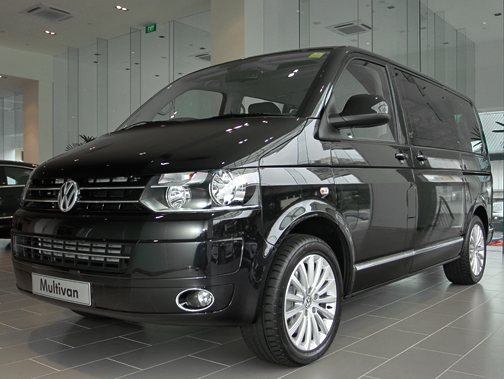
The 174-horsepower version is very common. According to reviews, the 2.5 liter Volkswagen Multivan is a compromise for those who want a dynamic car that does not consume a lot of fuel. The car consumes 10.5 liters of diesel per 100 kilometers in the city. On the highway the car is more economical and consumes 6.6 liters. This applies to the version with mechanics. An automatic transmission is also available for the 2.5-liter Volkswagen Multivan. With it the car will be more voracious. Consumption will be 12.3 and 7 liters in the city and on the highway, respectively.
Volkswagen Transporter fuel consumption
The Volkswagen Transporter is one of the most popular commercial vehicles of the VW group. The first generation of Transporter - T1, appeared back in 1950. Thanks to its unpretentiousness, reliability, as well as wide possibilities in the commercial sphere, the car quickly became popular not only in Europe, but throughout the world, including the USA.
Currently, the fifth generation of the VW Transporter T5 is being produced, on the basis of which a number of modifications have also been created: Caravelle, Multivan, DoKa and others.
Volkswagen Transporter T4
The fourth generation of the Transporter, for the first time for this model, received front-wheel drive and a front-mounted engine. Cars in this series were produced from 1990 to 2003 in six different body styles: from a model with blind sides to the luxury Caravel configuration and even a flatbed truck. Of the power units, the car was equipped with 1.8 - 2.8 liter gasoline engines, as well as 1.8 -2.5 liter diesel engines.
Fuel consumption per 100 km Volkswagen Transporter T4. Reviews
- Vladimir, Tver. Like 90% of T4 owners, I bought it for work. The van freely carries almost a ton of cargo, and you don’t even feel it. Handling is good, even on wet roads it feels confident. Many people take diesel, but because of the cold winters, I specifically took a 2.5 liter gasoline engine - it is unpretentious to the quality of gasoline. I fill up AI92 - in the city the consumption is up to 14 liters, on the highway - 10.
- Alexey, Novosibirsk. I have been involved in cargo transportation for almost 10 years and have worked on various vans and trucks. I heard a lot of good things about the T4, so I decided to buy it for transportation within the city. I chose the 1997 model, with a 2.5 liter gasoline engine. I’ve been using it for about a year and a half now – I’m happy with everything. Consumption, as for a gasoline engine, is small - on the highway about 9.5 liters, in the city - up to 13.
- Victor, Kaliningrad. In 2008, a ten-year-old T4 Transporter was brought to me from Germany. The condition was excellent, but the interior had to be touched up a little - the upholstery, floor covering and other small details were changed. We often go on nature trips with our families and also transport passengers – the Transporter is just right for this. I have a 1.9 liter diesel engine, the consumption is low - about 7 liters outside the city, in the city fully loaded - no more than 9.
- Alexander, Tyumen. VW Transporter, 2.4d, 4WD, 1998. An excellent car - high-torque and powerful. I've owned it for 3 years now and it has never let me down. I didn’t specifically take the version with a turbine - a regular diesel engine is much easier to maintain, and in terms of efficiency, everything is also excellent - in the city a maximum of 13 liters, and in the countryside 3-3.5 liters less.
- Peter, Tikhoretsk. When I began to expand my business, the need arose for a minivan or a small van, because I was constantly overpaying for cargo transportation. A friend advised us to take a Volkswagen Transporter T4, always with a diesel engine. I found a 1991 version with a 1.9 liter engine - a bit old, of course, but I don’t need another one to transport building materials. But, despite its age, nothing breaks - unlike my Priora. By the way, the consumption is even less than hers - in the city up to 8 liters of diesel fuel in total, this is with an almost full load.
- Sergey, Voronezh. In 2007, there was an urgent need to buy an inexpensive and practical van. Funds were limited, but we came across a good option - Transporter T4, produced in 1994. I’ve been driving it for eight years now, recently the consumption has increased - now in the city I have 10 liters, although before it was 8 (1.9 diesel engine). We need to go to the fuel workers, let them see what’s wrong.
- Pavel, Samara. About five years ago I had a T4 Transporter with a diesel engine, in a cargo version (solid, without windows). An excellent and reliable car, it didn’t break down at all. But then he switched to passenger transportation and, in order not to spend money on re-equipping the interior, he decided to sell the car and buy a Vito - it’s newer and more comfortable. I sold it quickly - literally in a couple of days. But by the way, the Tashka’s consumption is less than Vito’s - on the highway I had 7 liters in total, in the city up to 8.5.
- Philip, Krymsk. I work across the region and often have to transport cargo to remote places. I specifically chose a van with all-wheel drive - it turned out there weren't that many options. The best thing I came across was a T4 4WD with a 2.0 MT engine, 1998. Even when fully loaded, it pulls normally, both on dirt and dirt roads. With a loaded body in the city it comes out to 13-14 liters, on the highway - ten.
- Yakov, Kamensk. Volkswagen T4, 2.4 turbodiesel, 2000. I've been driving it for six years now - before that I bought it first-hand from the owner with 60 thousand mileage. There have been no serious repairs yet, only minor things, although I heard that the turbine quickly fails - all this is nonsense. In the city, the consumption is ridiculous - 13.5 liters (I compare it with my old Gazelle and am euphoric).
- Sergey, Moscow. The conveyor in any version is a workhorse, 100%. I myself have a 1999 T4, I’ve been driving it for 7 years. The only negative is that when fully loaded, the 1.9 diesel does not have enough power, but this is when you throw the body completely, which is rare. Otherwise, everything is fine and the consumption is small - I mostly drive on the highway, I get by with 7 liters. In the city from 8.5 to 13 - Moscow after all, traffic jams, sir.
Volkswagen Transporter review
A light commercial vehicle is designed to transport small loads or people. It is equipped with gasoline or diesel engines, manual transmission or automatic transmission. Body type: all-metal van or cargo - cab with flatbed. On new models, not a hydraulic unit is installed, but an electromechanical unit. Now the basic versions are equipped with Cross Wind Assist - a system that stabilizes the car in strong gusts of wind, electronics that will help keep the car on the rise, and other systems. Now the salon has an updated multimedia system, there is a built-in 200-volt socket.
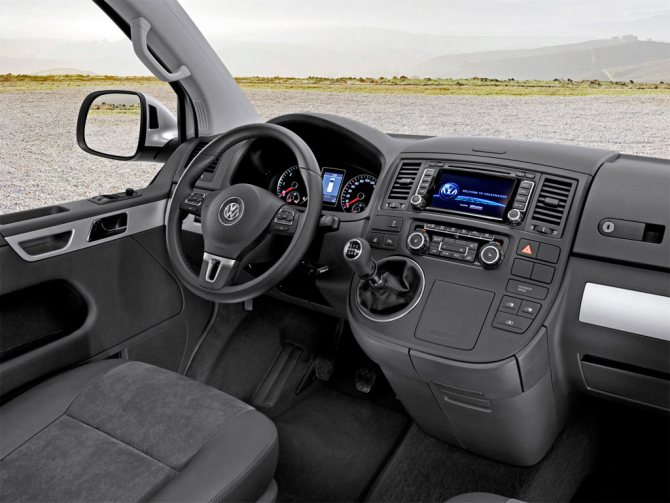
Official data (l/100 km)
| Engine | Consumption (city) | Consumption (highway) | Flow (mixed) |
| 1.9 MT diesel (manual) | — | — | 7.5 |
| 2.0 AT petrol (automatic) | 13.2 | 7.8 | 9.8 |
| 2.0 MT petrol (manual) | 12.8 | 7.8 | 9.6 |
| 2.0 AMT petrol (robot) | 13.2 | 7.8 | 9.8 |
| 2.0 AT diesel (automatic) | 10.0 | 6.7 | 7.9 |
| 2.0 MT diesel (manual) | 7.9 | 6.0 | 6.7 |
| 2.0 AMT diesel (robot) | 7.2 | 5.8 | 6.3 |
| 2.4 MT diesel (manual) | — | — | 9.2 |
| 2.5 MT diesel (manual) | — | — | 8.3 |
| 2.5 MT petrol (manual) | — | — | 12.6 |
| 3.2 MT petrol (manual) | — | — | 12.7 |
Like many cars, the Volkswagen Transporter is equipped with gasoline and diesel units. In the 1990 version (T4), the first ones started with a 2.0 unit with a power rating of 84 horsepower. It was controlled by a manual transmission with five gears. Fuel consumption per 100 km according to the passport was 11.1 liters. Next came the 2.5, with a peak of 115 horsepower. There was already an automatic transmission with four operating modes, as well as all-wheel drive. Its gasoline consumption is 12.5 liters.
The 2.8-liter device could boast 140 horses with a manual transmission and 204 with an automatic transmission. The average consumption here was 13.2 liters. Engines that consumed diesel started with version 1.9, developing 60 or 68 horsepower. It consumed 9.1 liters of fuel. It is also equipped with a two-liter engine, producing 84 horsepower. Its consumption rate is 9.3 l. The largest unit was considered to be 2.5, with a herd of 102 horses. It could also be all-wheel drive. This herd ate 7.6 liters of diesel. Here all the configurations were only manual.
“Like almost everything, my T4 Transporter was purchased for work needs. The truck was too big for me, but the van was just right. I dug it in 2015, although the car is 95. But even years do not affect its performance; it is indestructible. The consumption is just too high - almost 17 liters in the city,” wrote Zakhar from Krasnodar.
“I have been delivering large cargo for a very long time. I tried a lot of different options, but I was only hooked on this one – a comfortable and reliable Transporter. The car lasts for years. Mine was purchased fifteen years ago and there are still no complaints about its performance. Consumption only increased slightly from 13 to 15 liters in the city. But you can fill in any fuel, so this didn’t really affect the spending of money,” writes Rustam from Grozny.
The fifth generation of the car (T5) was released in 2003. Diesel options here are represented by 1.9 (102 horsepower) and 2.5 (131 and 174 horsepower) units. The first was paired with only a manual transmission variation, but with the second both were available, as was all-wheel drive. Fuel consumption varied from 7.7 to 9.4 liters. There were two representatives for gasoline trim levels: 2.0 (manual, 115 horsepower) and 3.2 (235 horsepower, both gearboxes and all-wheel drive). Their consumption was 10.7 and 12.9 liters.
“The car was driven straight from home. I had to invest a little in the interior, because in some unknown way it was all tattered. This is a pretty good truck, suitable for many tasks. The consumption is normal, 13 liters, no more,” said Dmitry from Kostroma.
“After my company grew, I had to deliver cargo on a larger scale, and since it was expensive to pay for it, I decided to buy a diesel-powered Transporter. I don’t need a lot of power, but I managed to save a lot on consumption – usually it comes out to 9 liters,” said Yuri from St. Petersburg.
Volkswagen Transporter engines. Official fuel consumption per 100 km.
Generation 3 (1979-1992)
- 1.6, 50 l. p., manual, rear, consumption – 15.7/11.2 l per 100 km
- 1.9, 60 l. p., manual, rear, consumption – 12.9/9.7 l per 100 km
- 1.9, 78 l. p., manual, rear, consumption – 13.3/9.4 l per 100 km
- 1.9, 83 l. p., manual, rear
- 1.9, 90 l. s.. manual, rear
- 2.0, 70 l. With. manual, rear, consumption – 15.4/11.1 l per 100 km
- 2.1, 95 l. s.. manual, rear, consumption – 15.6/13.8 l per 100 km
- 2.1, 112 l. p., mechanics, full, 112 l. p., manual, rear, consumption – 12/8.8 l per 100 km
- 1.6, 50 l. p., manual, rear
- 1.6, 70 l. p., manual, rear, consumption – 8.6/8.3 l per 100 km
- 1.7. 57 l. p., manual, rear, consumption – 8.9/8.5 l per 100 km
- 1.7, 57 l. s., manual, rear, consumption – 9.8/8 l per 100 km.
Generation 4 (1990-2003)
- 2.5, 110 l. p., manual, front
- 2.5, 115 l. p., automatic/mechanical, front/full
- 1.9, 68 l. p., manual, front
- 2.0, 84 l. p., manual, front
- 2.4, 78 l. p., mechanics, complete
- 2.4, 78 l. pp., manual, front, consumption – 11.7/7.9 l per 100 km
- 2.4, 75 l. p., manual, front
- 2.5, 88 l. p., manual, front
- 2.5, 102 l. p., manual, front/full
- 2.5, 115 l. p., automatic/mechanical, front/full
Generation 5 (2003-2009)
- 2.0, 115 l. p., manual, front
- 3.2, 235 l. p., manual/automatic, front/full
- 1.9, 102 l. p., manual, front
- 1.9, 105 l. p., manual, front
- 1.9, 85 l. p., manual, front
- 2.0, 115 l. p., manual, front
- 2.5, 174 l. p., manual, front
- 2.5, 131 l. p., automatic/mechanical, front/full.
Generation 5 (restyling, 2009-2015)
- 2.0, 204 l. p., manual/automatic, front/full
- 2.0, 84 l. p., manual, front
- 2.0, 102 l. p., manual, front
- 2.0, 140 l. p., manual/automatic, front/full
- 2.0, 180 l. p., mechanics, complete
- 2.0, 180 l. p.s., automatic, full, consumption – 10.9/7.3 l per 100 km
- 2.0, 204 l. p., manual/automatic, front/full.
Generation 6 (from 2020)
- 2.0, 150 l. p., manual, front, consumption – 12.8/7.8 l per 100 km
- 2.0, 204 l. p., robot, front, consumption – 13.2/7.8 l per 100 km
- 2.0, 204 l. pp., robot, full, consumption – 13.8/8.3 l per 100 km
- 2.0, 102 l. p., manual, front, consumption – 8.3/5.8 l per 100 km
- 2.0, 140 l. p., manual, front, consumption – 9.6/6.3 l per 100 km
- 2.0, 140 l. p., robot, front, consumption – 10.2/6.7 l per 100 km
- 2.0, 180 l. p., robot, front, consumption – 10/6.7 l per 100 km
- 2.0, 180 l. s., robot, full, consumption – 10.9/7.3 l per 100 km.
Volkswagen Transporter T4, T5 fuel consumption 1.9, 2.4, 2.5 diesel and gasoline
Production of the Transporter model began in 1950. Then the minivan was produced under the name T1. The most successful and best-selling models were the T4 and T5. They have an original modern design and fairly good technical equipment, and most importantly, they are affordable. VW T4 was produced from 1990 to 2003. During this period, the car underwent restyling and changed the generation of engines. Maximum speed is up to 162 km/h. Issue T5 went on sale in 2004. Maximum speed is 188 km/h. Although the brand new T6 has already appeared in showrooms, the fifth model has not yet rolled off the assembly line.
Volkswagen Transporter T4
In 1990, the car was launched with 1.8, 2.0, 2.5 liter petrol engines and 1.9, 1.9TDI and 2.4 liter diesel engines. Later in 1996, a gasoline 2.8 and 2.5 turbodiesel appeared, which replaced the two previous diesel engines. Average consumption in the mixed cycle is from 7.7 liters to 12.6 liters on the most “charged” version.
Real fuel consumption
- Vladimir, Moscow. VW T4 2000 2.4d. The car is in excellent condition for its age. Naturally, some parts were replaced, but it still runs without problems. Easy to drive, holds the road well. Fuel consumption in the city is 13 liters in the city and 10.5 liters on the highway.
- Alexey, Tver. I have been driving a 2000 Transporter T4 for the sixth year now. The engine is 1.9d. The car is for work and in principle I am happy with it. Sometimes there is a little lack of power when loaded, but it goes quite briskly. Good driving position with full visibility. Consumption is small: in the city from 8 to 11 liters. On the highway, if you drive no higher than 90 km/h, then you can easily manage 7 liters.
- Victor, Novosibirsk. I bought the T4 for work, like many others, probably. Model 1995, 2.5 petrol engine. It rides well, holds up well on wet roads and slush. I didn’t take diesel only because it’s often cold and problems can arise. Fuel consumption is not scary, because the car is unpretentious - it runs smoothly at 92 and even at 86. Consumption in the city is 13-14 liters in the city and 10 liters on the highway.
- Alexander, Kaliningrad. Volkswagen T4 1997 2.5 petrol. I have been working in transportation for 10 years. I’ve been driving similar cars for a long time, but for a long time I heard positive reviews about the T4 and so I decided to buy it. An excellent minivan, despite its “advanced” age. It drives great, has a good view, and is simple in size. Fuel consumption in the city is about 12 liters, on the highway – 9.5 liters.
- Peter, Tyumen. In 2008, I bought a 1998 T4 and still drive it. The car was completely redone. I am engaged in passenger transportation and often go outdoors with friends. I replaced all the seats, reupholstered the interior, repainted the body, and overall the result was a new van. Fuel consumption is very low - 8.5-9 liters in the city, 7 liters on the highway. I have a 1.9d diesel with 68 hp.
- Sergey, Tikhoretsk. I've been driving a wonderful T4 98 car for 3 years now. There is no turbine, but all-wheel drive does a great job of it. Diesel engine 2.4 liters, power 78 hp. enough, behaves excellent off-road. True, if you drive through puddles and the water gets just above the threshold, the traction will drop. Fuel consumption in the city is 13 liters, on the highway 10 liters.
- Pasha, Voronezh. Volkswagen T4 1.9d. I needed an inexpensive but reliable all-wheel drive minivan for work, and all my friends recommended only VW. I'm happy with the car and thank everyone for the good advice. Fuel consumption is ridiculous for such a car, in the city from 6 to 8 liters per 100 km. Model of the 94th year of release.
- Philip, Samara. I've been driving this minivan since 2005. VW T4 1991 1.9 MT. At that time there was an urgent need to purchase a van. Almost without thinking, I took what was closest. It turned out to be a Volkswagen T4. I’ve been driving for 10 years, so it’s not difficult to understand that I’m 100% happy with the car. Diesel fuel consumption is low - in the city it’s within 10 liters, and on average it’s 8.5 liters per hundred square meters.
- Yakov, Krymsk. Owned a 7 year old 1991 Transporter 1.9TDI SUV. When I decided to sell, a buyer was found within a day. I bought a Vito as a replacement, but I regret it a little, since the fuel consumption of the leaker was less: only 8.5 liters in the city and 7 liters of diesel on the highway.
- Sergey, Kamensk. I've been driving a T4 not too long ago. I got a used 1998 model, a 2.0-liter gasoline engine with a manual transmission. The car is excellent, peppy. All-wheel drive copes well with dirt roads and off-road conditions. Often you have to load it with luggage, but the seating position does not change. Fuel consumption was a pleasant surprise: on the highway 8 liters, in the city up to 13 liters maximum.
Volkswagen Transporter T5
Fuel consumption rate per 100 km
T5 diesel engines are equipped with a turbocharger - a pump, due to which fuel injection is reduced and consumption is reduced. An engine with a volume of 2.5 liters has been added to the line of diesel engines. Variations of the remaining power plants did not change until 2012, they added a little power and a 3.2-liter appeared in the maximum configuration. Average fuel consumption: from 7.3 to 13.3 liters per 100 km.
